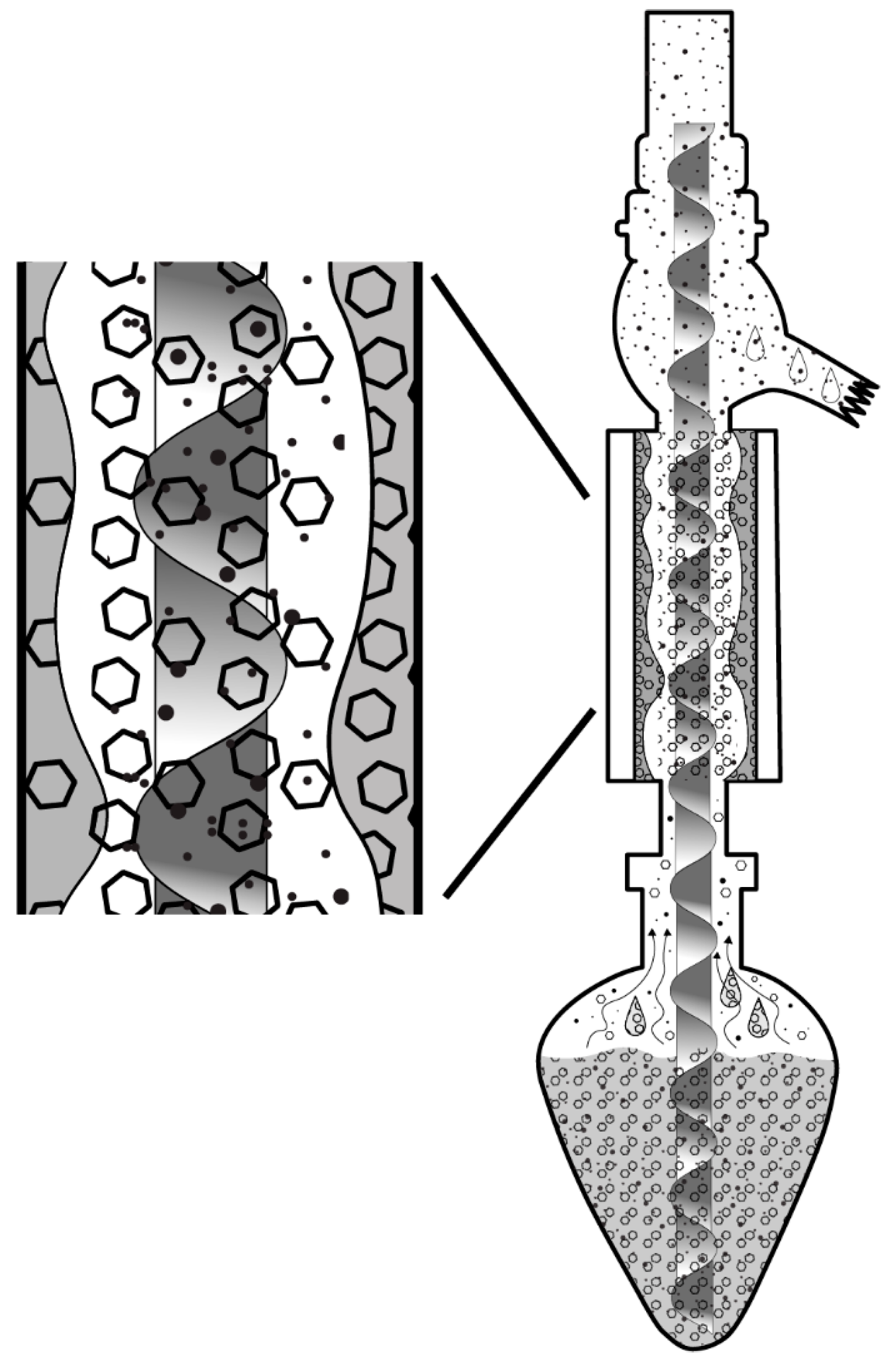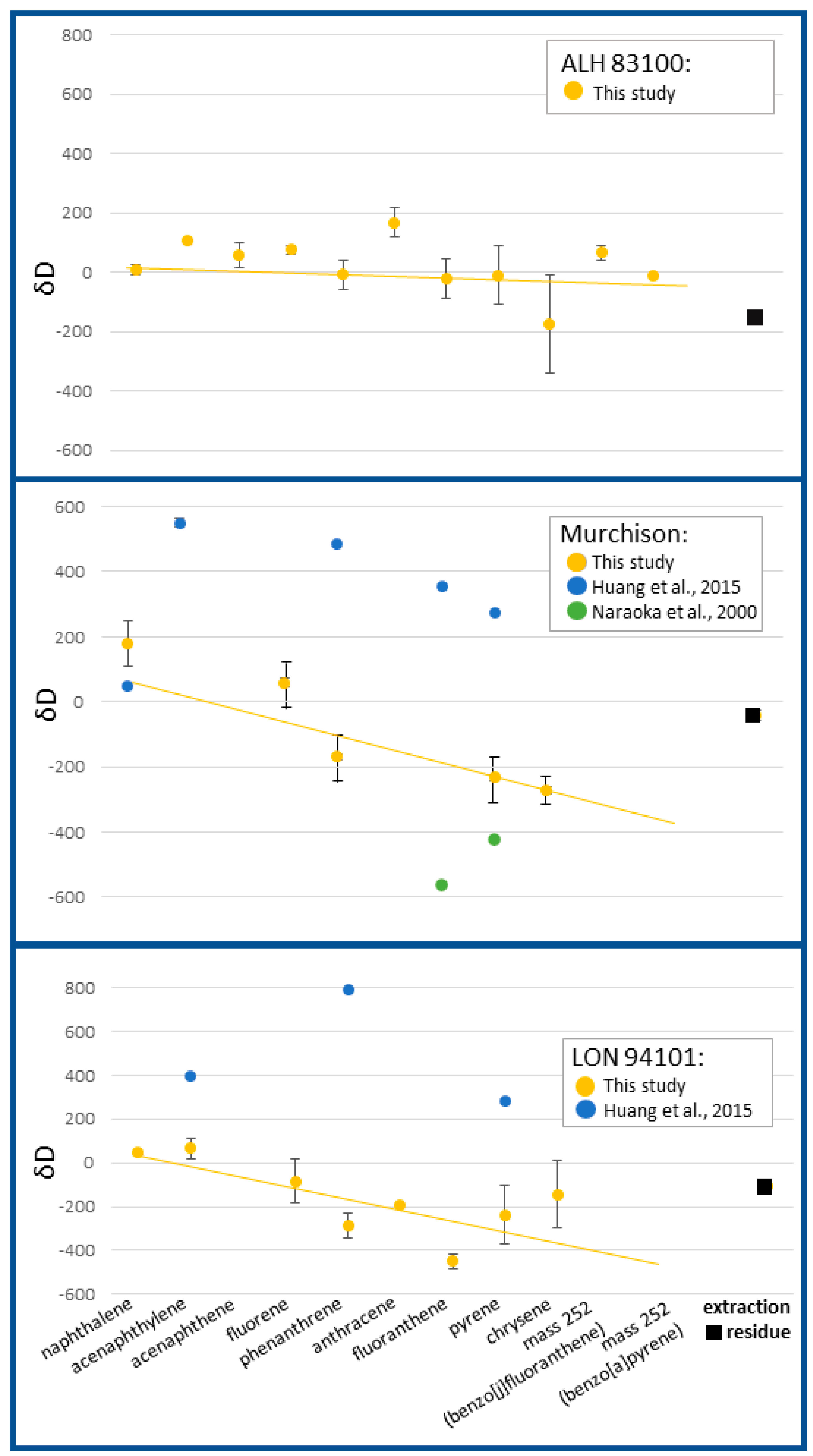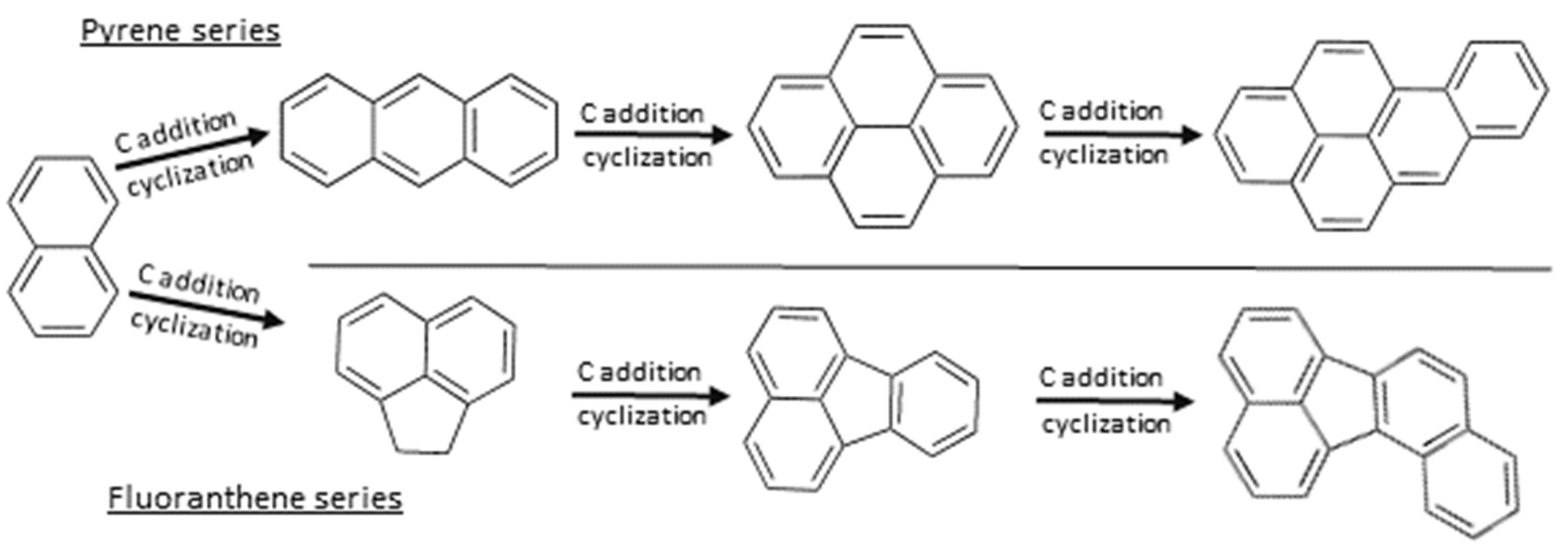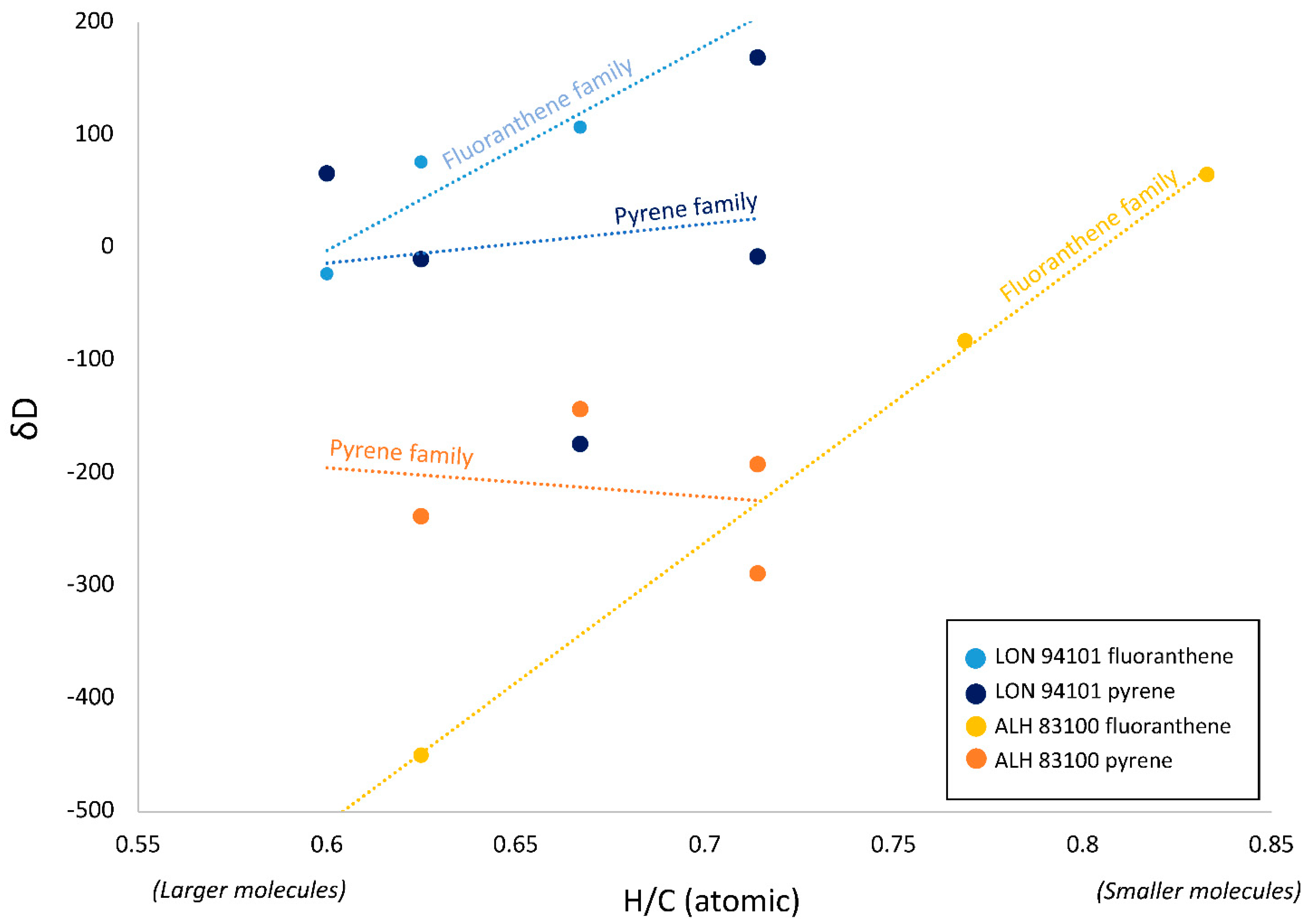Deuterium Isotope Fractionation of Polycyclic Aromatic Hydrocarbons in Meteorites as an Indicator of Interstellar/Protosolar Processing History
Abstract
1. Introduction
1.1. Reduced Carbon Chemistry and the Early Evolution of the Solar System
1.2. The Role of Deuterium in Understanding the Origin of PAHs
2. Methods
Prevention of Volatile Loss and Limitation of Isotope Fractionation
3. Results
4. Discussion
4.1. Generally Light Isotopic Values for Isolated PAHs
4.2. PAH Origin Estimations Based on D/H Trends with Ring Size
4.3. Parent-Body Alteration and PAH Deuterium Enrichment
4.4. Comparisons with Previous Data Indicate D/H Depletion in Soluble Species
5. Conclusions
Supplementary Materials
Author Contributions
Funding
Institutional Review Board Statement
Informed Consent Statement
Data Availability Statement
Acknowledgments
Conflicts of Interest
References
- Pearson, V.K.; Sephton, M.A.; Gilmour, I. Molecular and isotopic indicators of alteration in CR chondrites. Meteorit. Planet. Sci. 2006, 41, 1291–1303. [Google Scholar] [CrossRef]
- Sephton, M.A.; Love, G.D.; Meredith, W.; Snape, C.E.; Sun, C.G.; Watson, J. Hydropyrolysis: A new technique for the analysis of macromolecular material in meteorites. Planet. Space Sci. 2005, 53, 1280–1286. [Google Scholar] [CrossRef]
- Pizzarello, S.; Cronin, J.R.; Flynn, G. The nature and distribution of the organic material in carbonaceous chondrites and interplanetary dust particles. In Meteorites and the Early Solar System II; Lauretta, D.S., Ed.; University of Arizona Press: Tucson, AZ, USA, 2006; pp. 625–651. [Google Scholar]
- Pizzarello, S.; Shock, E. The organic composition of carbonaceous meteorites: The evolutionary story ahead of biochemistry. Cold Spring Harb. Perspect. Biol. 2010, 2, a002105. [Google Scholar] [CrossRef]
- Schmitt-Kopplin, P.; Gablica, Z.; Gougeon, R.D.; Fekete, A.; Kanawati, B.; Harir, M.; Gebefuegi, I.; Eckel, G.; Hertkorn, N. High molecular diversity of extraterrestrial organic matter in Murchison meteorite revealed 40 years after its fall. Proc. Natl. Acad. Sci. USA 2010, 107, 2763–2768. [Google Scholar] [CrossRef]
- Allamandola, L.J.; Sandford, S.A.; Wopenka, B. Interstellar polycyclic aromatic hydrocarbons and carbon in interplanetary dust particles and meteorites. Science 1987, 237, 56–59. [Google Scholar] [CrossRef]
- Leger, A.; D’Hendencourt, L.; Defourneau, D. Physics of IR emission by interstellar PAH molecules. Astron. Astrophys. 1989, 216, 148–164. [Google Scholar]
- Tielens, A.G.G.M. The molecular universe. Rev. Mod. Phys. 2013, 85, 1021–1081. [Google Scholar] [CrossRef]
- Allamandola, L.J.; Tielens, A.G.G.M.; Barker, J.R. Interstellar polycyclic aromatic hydrocarbons and carbon: The infrared emission bands, the excitation/emission mechanism, and the astrophysical implications. Astrophys. J. 1989, 71, 733–755. [Google Scholar] [CrossRef]
- Pascoli, G.; Polleux, A. Condensation and growth of hydrogenated carbon clusters in carbon-rich stars. Astron. Astrophys. 2002, 359, 799–810. [Google Scholar]
- McGuire, B.A.; Loomis, R.A.; Burkhardt, A.M.; Lee, K.L.K.; Shingledecker, C.N.; Charnley, S.B.; Cooke, I.R.; Cordiner, M.A.; Herbst, E.; Kalenski, S.; et al. Detection of two interstellar polycyclic aromatic hydrocarbons via spectral matched filtering. Science 2021, 371, 1265–1269. [Google Scholar] [CrossRef]
- Berné, O.; Montillaud, J.; Joblin, C. Top-down formation of fullerenes in the interstellar medium. Astron. Astrophys. 2015, 577, A135. [Google Scholar] [CrossRef]
- Martínez, L.; Santoro, G.; Merino, P.; Accolla, M.; Lauwaet, K.; Sobrado, J.; Sabbah, H.; Pelaez, R.J.; Herrero, V.J.; Tanarro, I.; et al. Prevalence of non-aromatic carbonaceous molecules in the inner regions of circumstellar envelopes. Nat. Astron. 2020, 4, 97–105. [Google Scholar] [CrossRef]
- Jones, B.M.; Zhang, F.; Kaiser, R.I.; Jamal, A.; Mebel, A.M.; Cordiner, M.A. Charnley, Formation of benzene in the interstellar medium. Proc. Natl. Acad. Sci. USA 2011, 108, 452–457. [Google Scholar] [CrossRef]
- Cleeves, I.; Bergin, E.A.; Alexander, C.M.O.; Du, F.; Graninger, D.; Öberg, K.I.; Harries, T.J. Exploring the origins of deuterium enrichments in solar nebular organics. Astrophys. J. 2016, 115, E6. [Google Scholar]
- Ehrenfreund, P.; Charnley, S.B. Organic molecules in the interstellar medium, comets, and meteorites: A voyage from dark clouds to the early earth. Ann. Rev. Astron. Astrophys. 2000, 38, 427–483. [Google Scholar] [CrossRef]
- Messenger, S. Identification of molecular-cloud material in interplanetary dust particles. Nature 2000, 404, 968–971. [Google Scholar] [CrossRef]
- McKay, A.J.; Roth, N.X. Organic matter in cometary environments. Life 2021, 11, 37. [Google Scholar] [CrossRef]
- Mullie, F.; Reisse, J. Organic matter in carbonaceous chondrites. In Topics in Current Chemistry; Springer: Berlin/Heidelberg, Germany, 1987; Volume 139, pp. 85–117. [Google Scholar]
- Cronin, J.R.; Pizzarello, S.; Cruikshank, D.P. Organic matter in carbonaceous chondrites, planetary satellites, asteroids and comets. In Meteorites and the Early Solar System; Greenberg, J.M., Mendoza, C.X., Matthews, M.S., Eds.; University of Arizona Press: Tucson, AZ, USA, 1988; pp. 819–857. [Google Scholar]
- Glavin, D.P.; Alexander, C.M.O.; Aponte, J.C.; Dworkin, J.P.; Elsila, J.E.; Yabuta, H. The origin and evolution of organic matter in carbonaceous chondrites and links to their parent bodies. In Primitive Meteorites and Asteroids: Physical, Chemical and Spectroscopic Observations Paving the Way to Exploration; Abreu, N., Ed.; Elsevier: Amsterdam, The Netherlands, 2018; pp. 205–271. [Google Scholar]
- Basile, B.P.; Middleditch, B.S.; Oró, J. Polycyclic aromatic hydrocarbons in the Murchison meteorite. Org. Geochem. 1984, 5, 211–216. [Google Scholar] [CrossRef]
- Shimoyama, A.; Katsumata, H. Polynuclear aromatic thiophenes in the Murchison carbonaceous chondrite. Chem. Lett. 2001, 30, 202–203. [Google Scholar] [CrossRef]
- Sephton, M.A. Organic compounds in carbonaceous meteorites. Nat. Prod. Rep. 2002, 19, 292–311. [Google Scholar] [CrossRef]
- Elsila, J.E.; de Leon, N.P.; Buseck, P.R.; Zare, R.N. Alkylation of polycyclic aromatic hydrocarbons in carbonaceous chondrites. Geochim. Cosmochim. Acta 2005, 69, 1349–1357. [Google Scholar] [CrossRef]
- Tielens, A.G.G.M. Interstellar polycyclic aromatic hydrocarbon molecules. Ann. Rev. Astron. Astrophys. 2008, 46, 289–337. [Google Scholar] [CrossRef]
- Kerridge, J.F.; Chang, S. Survival of interstellar matter in meteorites: Evidence from carbonaceous material. In Protostars and Planets II; Black, D.C., Matthews, M.S., Eds.; University of Arizona Press: Tucson, AZ, USA, 1985; pp. 738–754. [Google Scholar]
- Sandford, S.A. Interstellar processes leading to molecular deuterium enrichment and their detection. Planet. Space Sci. 2002, 50, 1145–1154. [Google Scholar] [CrossRef][Green Version]
- Sandford, S.A.; Bernstein, M.P.; Dworkin, J.P. Assessment of the interstellar processes leading to deuterium enrichment in meteoritic organics. Meteorit. Planet. Sci. 2001, 36, 1117–1133. [Google Scholar] [CrossRef]
- Naraoka, H.; Takano, Y.; Dworkin, J.P. The Hayabusa2-initial-analysis SOM team. Soluble organic compounds in asteroid 162173 Ryugu. Lunar Planet. Sci. LIII 2022, Abs1781. [Google Scholar]
- Plows, F.L.; Elsila, J.E.; Zare, R.N.; Buseck, P.R. Evidence that polycyclic aromatic hydrocarbons in two carbonaceous chondrites predate parent-body formation. Geochim. Cosmochim. Acta 2003, 67, 1429–1436. [Google Scholar] [CrossRef]
- Huang, Y.; Wang, Y.; Alexandre, M.R.; Lee, T.; Rose-Petruck, C.; Fuller, M.; Pizzarello, S. Molecular and compound specific isotopic characterization of monocarboxylic acids in carbonaceous meteorites. Geochim. Cosmochim. Acta 2005, 69, 1073–1084. [Google Scholar] [CrossRef]
- Pizzarello, S.; Huang, Y. A deuterium enrichment of individual amino acids in carbonaceous meteorites: A case for the presolar distribution of biomolecules precursors. Geochim. Cosmochim. Acta 2005, 69, 599–605. [Google Scholar] [CrossRef]
- Glavin, D.P.; Dworkin, J.P.; Aubrey, A.; Botta, O.; Doty, J.H., III; Martins, Z.; Bada, J.L. Amino acid analyses of Antarctic CM2 meteorites using liquid chromatograph-time of flight-mass spectrometry. Meteorit. Planet. Sci. 2006, 41, 889–902. [Google Scholar] [CrossRef]
- Elsila, J.E.; Charnley, S.B.; Burton, A.S.; Glavin, D.P.; Dworkin, J.P. Compound-specific carbon, nitrogen, and hydrogen isotopic ratios for amino acids in CM and CR chondrites and their use in evaluating potential formation pathways. Meteorit. Planet. Sci. 2012, 47, 1517–1536. [Google Scholar] [CrossRef]
- Halbout, J.; Robert, F.; Javoy, M. Hydrogen and oxygen isotope compositions in kerogen from the Orgueil meteorite: Clues to a solar origin. Geochim. Cosmochim. Acta 1990, 54, 1453–1462. [Google Scholar] [CrossRef]
- Krishnamurthy, R.V.; Epstein, S.; Cronin, J.R.; Pizzarello, S.; Yuen, G.U. Isotopic and molecular analyses of hydrocarbons and monocarboxylic acids of the Murchison meteorite. Geochim. Cosmochim. Acta 1992, 56, 4045–4058. [Google Scholar] [CrossRef]
- Naraoka, H.; Mita, H.; Komiya, M.; Shimoyama, A. δD of individual PAHs from the Murchison and an Antarctic carbonaceous chondrite. Geochim. Cosmochim. Acta 2002, 66, A546. [Google Scholar]
- Huang, Y.; Aponte, J.C.; Tarozo, R.; Hallmann, C. Hydrogen and carbon isotopic ratios of polycyclic aromatic compounds in two CM2 carbonaceous chondrites and implications for prebiotic organic synthesis. Earth Planet. Sci. Lett. 2015, 426, 101–108. [Google Scholar] [CrossRef]
- Naraoka, H.; Shimoyama, A.; Harada, K. Isotopic evidence from an Antarctic carbonaceous chondrite for two reaction pathways of extraterrestrial PAH formation. Earth Planet. Sci. Lett. 2000, 184, 1–7. [Google Scholar] [CrossRef]
- Tielens, A.G.G.M. Deuterium and interstellar chemical processes. In Astrophysical Implications of the Laboratory Study of Presolar Materials; Bernatowicz, T.J., Zimmer, E., Eds.; American Institute of Physics Press: College Park, MD, USA, 1997; pp. 523–544. [Google Scholar]
- Millar, T.J.; Roberts, H.; Markwick, A.J.; Charnley, S.B. The role of H2D+ in the deuteration of interstellar molecules. Philos. Trans. R. Soc. Lond. A 2000, 358, 2535–2547. [Google Scholar] [CrossRef]
- Alexander, C.M.O.; Howard, K.; Bowden, R.; Fogel, M.L. The classification of DM and CR chondrites using bulk H, C and N abundances and isotopic compositions. Geochim. Cosmochim. Acta 2013, 123, 244–260. [Google Scholar] [CrossRef]
- Rubin, A.E.; Trigo-Rodriguez, J.M.; Huber, H.; Wasson, J.T. Progressive aqueous alteration of CM carbonaceous chondrites. Geochim. Cosmochim. Acta 2007, 71, 2361–2382. [Google Scholar] [CrossRef]
- Burgoyne, T.W.; Hayes, J.M. Quantitative production of H2 by pyrolysis of gas chromatographic effluents. Anal. Chem. 1999, 70, 5136–5141. [Google Scholar] [CrossRef]
- Constable, D.J.C.; Smith, R.S.; Tanaka, J. Comparison of solvent reduction methods for concentration of polycyclic aromatic hydrocarbon solutions. Environ. Sci. Technol. 1984, 18, 975–978. [Google Scholar] [CrossRef]
- Oba, Y.; Naraoka, H. Elemental and isotope behavior of macromolecular organic matter from CM chondrites during hydrous pyrolysis. Meteorit. Planet. Sci. 2009, 44, 943–953. [Google Scholar] [CrossRef]
- Vacher, L.G.; Piani, L.; Rigaudier, T.; Thomassin, D.; Florin, G.; Piralla, M.; Marrocchi, Y. Hydrogen in chondrites: Influence of parent body alteration and atmospheric contamination on primordial components. Geochim. Cosmochim. Acta 2020, 281, 53–66. [Google Scholar] [CrossRef]
- Robert, F.; Epstein, S. The concentration and isotopic composition of hydrogen, carbon and nitrogen in carbonaceous meteorites. Geochim. Cosmochim. Acta 1982, 46, 81–95. [Google Scholar] [CrossRef]
- Wang, Z.; Huang, Y.; Alexander, C.M.O.; Fogel, M.; Cody, G. Molecular and compound-specific hydrogen isotope analyses of insoluble organic matter from different carbonaceous chondrite groups. Geochim. Cosmochim. Acta 2005, 69, 3711–3721. [Google Scholar] [CrossRef]
- Alexander, C.M.O.; Fogel, M.L.; Yabuta, H.; Cody, G.D. The origin and evolution of chondrites recorded in the elemental and isotopic compositions of their macromolecular organic matter. Geochim. Cosmochim. Acta 2007, 71, 4380–4403. [Google Scholar] [CrossRef]
- Remusat, L.; Palhol, F.; Robert, F.; Derenne, S.; France-Lanord, C. Enrichment of deuterium in insoluble organic matter from primitive meteorites: A solar system origin? Earth Planet. Sci. Lett. 2006, 243, 15–25. [Google Scholar] [CrossRef]
- Bechalany, A.; El Tayar, N.; Carrupt, P.-A.; Testa, B.; Falconnet, J.-B.; Cherrah, Y.; Benchedroun, Y.; Brazier, J.-L. Isotope effects on the lipophilicity of deuterated caffeines. Helvetica 1989, 3, 472–476. [Google Scholar] [CrossRef]
- Puget, J.L.; Leger, A. A new component of the interstellar matter: Small grains and large aromatic molecules. Ann. Rev. Astron. Astrophys. 1989, 27, 161–198. [Google Scholar] [CrossRef]
- Wiersma, S.D.; Candian, A.; Bakker, J.M.; Martens, J.; Berden, G.; Oomens, J.; Jan Buma, W.; Petrignani, A. Photolysis-induced scrambling of PAHs as a mechanism for deuterium storage. Astron. Astrophys. 2020, 635, A9. [Google Scholar] [CrossRef]
- Hudgins, D.M.; Sandford, S.A.; Allamandola, L.J. Infrared spectroscopy of polycyclic aromatic hydrocarbon cations, I: Matrix-isolated naphthalene and perdeuterated naphthalene. J. Phys. Chem. 1994, 98, 4243–4253. [Google Scholar] [CrossRef]
- Allamandola, L.J.; Hudgins, D.M.; Sandford, S.A. Modeling the unidentified infrared emission with combinations of polycyclic aromatic hydrocarbons. Astrophys. J. 1999, 511, L115–L119. [Google Scholar] [CrossRef] [PubMed]
- Dalgarno, A.; Lepp, S. Deuterium fractionation mechanisms in interstellar clouds. Astrophys. J. 1984, 287, L47–L50. [Google Scholar] [CrossRef]
- Norman, C.; Silk, J. Clumpy molecular clouds: A dynamic model self-consistently regulated by T Tauri star formation. Astrophys. J. 1980, 238, 158–174. [Google Scholar] [CrossRef]
- Tielens, A.G.G.M. Surface chemistry of deuterated molecules. Astron. Astrophys. 1983, 119, 177–184. [Google Scholar]
- Bernstein, M.P.; Sandford, S.A.; Allamandola, L.J. UV irradiation of polycyclic aromatic hydrocarbons in ices: Production or alcohols, quinones, and ethers. Science 1999, 283, 1135–1138. [Google Scholar] [CrossRef]
- McSween, H.Y., Jr. Alteration in CM carbonaceous chondrites inferred from modal and chemical variations in matrix. Geochim. Cosmochim. Acta 1979, 43, 1761–1770. [Google Scholar] [CrossRef]
- Clark, B.E.; Ziffer, J.; Nesvorny, D.; Campins, H.; Rivkin, A.S.; Hiroi, T.; Barucci, M.A.; Fulchignoni, M.; Binzel, R.P.; Fornasier, S.; et al. Spectroscopy of B-type asteroids: Subgroups and meteorite analogs. J. Geophys. Res. Planets 2010, 70, 5136–5141. [Google Scholar] [CrossRef]
- Piani, L.; Robert, F.; Remusat, L. Micron-scale D/H heterogeneity in chondrite matrices: A signature of the pristine solar system water? Earth Planet. Sci. Lett. 2015, 415, 154–164. [Google Scholar] [CrossRef]
- Eiler, J.M.; Kitchen, N. Hydrogen isotope evidence for the origin and evolution of the carbonaceous chondrites. Geochim. Cosmochim. Acta 2004, 68, 1395–1411. [Google Scholar] [CrossRef]
- Palguta, J.; Schubert, G.; Travis, B.J. Fluid flow and chemical alteration in carbonaceous chondrite parent bodies. Earth Planet. Sci. Lett. 2010, 296, 235–243. [Google Scholar] [CrossRef]
- Gilmour, I.; Pillinger, C.T. Isotopic differences between PAH isomers in Murchison. Meteoritics 1992, 27, 224–225. [Google Scholar]
- Yuen, G.; Blair, N.; DesMarais, D.J.; Chang, S. Carbon isotope composition of low molecular weight hydrocarbons and monocarboxylic acids from Murchison meteorite. Nature 1984, 307, 252–254. [Google Scholar] [CrossRef] [PubMed]
- Alexander, C.M.O.; Cody, G.D.; De Gregorio, B.T.; Nittler, L.R.; Stroud, R.M. The nature, origin and modification of insoluble organic matter in chondrites, the possibly interstellar source of Earth’s C and N. Geochemistry 2017, 77, 227–256. [Google Scholar] [CrossRef] [PubMed]
- Sephton, M.A.; Pillinger, C.T.; Gilmour, I. Small-scale hydrous pyrolysis of macromolecular material in meteorites. Planet. Space Sci. 1998, 47, 181–187. [Google Scholar] [CrossRef]
- Sephton, M.A.; Pillinger, C.T.; Gilmour, I. Aromatic moieties in meteoritic macromolecular materials: Analyses by hydrous pyrolysis and δ13C of individual compounds. Geochim. Cosmochim. Acta 2000, 64, 321–328. [Google Scholar] [CrossRef]
- Sephton, M.A.; Gilmour, I. Compound-specific isotope analysis of the organic constituents in carbonaceous chondrites. Mass Spec. Rev. 2001, 20, 111–120. [Google Scholar] [CrossRef]
- Laurent, B.; Roskosz, M.; Remusat, L.; Robert, F.; Leroux, H.; Vezin, H.; Depecker, C.; Nuns, N.; Lefebvre, J.-M. The deuterium/hydrogen distribution in chondritic organic matter attests to early ionizing irradiation. Nat. Comms. 2015, 6, 8567. [Google Scholar] [CrossRef]
- Wing, M.R.; Bada, J.L. Geochromatography on the parent body of the carbonaceous chondrite Ivuna. Geochim. Cosmochim. Acta 1991, 55, 2937–2942. [Google Scholar] [CrossRef]
- Ehrenfreund, P.; Glavine, D.P.; Botta, O.; Cooper, G.; Bada, J.L. Extraterrestrial amino acids in Orgueil and Ivuna: Tracing the parent body of CI type carbonaceous chondrites. Proc. Natl. Acad. Sci. USA 2001, 98, 2138–2141. [Google Scholar] [CrossRef]
- Aponte, J.C.; Dworkin, J.P.; Elsila, J.E. Indigenous aliphatic amines in the aqueously altered Orgueil meteorite. Meteorit. Planet. Sci. 2015, 50, 1733–1749. [Google Scholar] [CrossRef]
- Lauretta, D.S.; Balram-Knutson, S.S.; Beshore, E.; Boynton, W.V.; Drouet d’Aubigny, C.; DellaGiustin, D.N.; Enos, H.L.; Gholish, D.R.; Hergenrother, C.W.; Howell, E.S.; et al. OSIRIS-REx: Sample return from asteroid (101955) Bennu. Space Sci. Rev. 2017, 212, 925–984. [Google Scholar] [CrossRef]







| Reaction/Environment | Mechanism/Location | Deuteration Pattern |
|---|---|---|
| Unimolecular photodissociation (warm and cold environments, UV photon-driven) | Gas-phase PAHs in interstellar medium or dense interstellar molecular clouds [29] | Smaller PAHs more enriched, no effect on >40 carbons |
| Gas-phase ion–molecule (cold environments) | Gas-phase PAHs in cold dense interstellar molecular clouds or cold regions of protosolar disks [28,29] | No enrichment trend with molecule size or ring number |
| Photo enrichment of PAHs in D-enriched ices (cold environments, UV photon-driven) | PAHs condensed in ices in dense interstellar molecular clouds or cold regions of protosolar disks [29] | No enrichment trend with molecule size or ring number (enrichment correlates with functionalization) |
| Cyclization pathways (kinetic reactions in parent body) | Larger PAH formation by ring addition in chondrite parent body [40] | Differs between partially and fully aromatized PAHs |
| Structure and Name | Formula Mass H/C | ALH 83100 δD (SMOW) | Murchison δD (SMOW) | LON 94101 δD (SMOW) |
|---|---|---|---|---|
| Pyrene Family: Six-Membered Fully Aromatic (Alternant) PAHs | ||||
 Naphthalene | C10H8 128 Da 0.8 | 7‰ ± 18‰ | 180‰ ± 70‰ | 46‰ ± 6‰ |
 Phenanthrene | C14H10 178 Da 0.714 | −8‰ ± 50‰ | −170‰ ± 8‰ | −289‰ ± 57‰ |
 Anthracene | C14H10 178 Da 0.714 | 169‰ ± 49‰ | n.d. | −192‰ ± 4‰ |
 Chrysene | C18H12 228 Da 0.667 | −174‰ ± 166‰ | −272‰ ± 12‰ | −143‰ ± 154‰ |
 Pyrene | C16H10 202 Da 0.625 | −10‰ ± 99‰ | −233‰ ± 7‰ | −238‰ ± 134‰ |
 Benzo[a]pyrene | C20H12 252 Da 0.6 | −12‰ ± 7‰ | n.d. | n.d. |
| Fluoranthene Family: Five-Membered Containing Fully or Partially Aromatic (Nonalternant) PAHs | ||||
 Acenaphthylene | C12H8 152 Da 0.667 | 107‰ ± 7‰ | n.d. | n.d. |
 Acenaphthene | C12H10 154 Da 0.833 | 58‰ ± 41‰ | n.d. | 65‰ ± 47‰ |
 Fluorene | C13H10 166 Da 0.769 | 76‰ ± 14‰ | 59‰ ± 14‰ | −83‰ ± 102‰ |
 Fluoranthene | C16H10 202 Da 0.625 | −23‰ ± 67‰ | n.d. | −450‰ ± 32‰ |
 Benzo[j]fluoranthene | C20H12 252 Da 0.6 | 66‰ ± 25‰ | n.d. | n.d. |
| Meteorite | Bulk Rock δD | Extraction Residue δD | IOM δD | Aromatic Fraction δD | Fluoranthene δD | Pyrene δD |
|---|---|---|---|---|---|---|
| A-881458 (CM2, very weakly heated) | +903‰ [47] | −219‰ [38] d | −168‰ [38] d | |||
| LON 94101 (CM 2; 1.8 [43]/2.6 [44]) | −154.6 ± 3.1‰ [48] | −105 ± 0.06‰ b | +1093‰ [49] | −450 ± 32‰ b | −238 ± 134‰ b + 57‰ [39] e | |
| Murchison (CM 2; 1.6 [43]/2.5 [44]) | −74.9 ± 0.9‰ [48] | −42 ± 0.06‰ b | +986‰ [47] +696‰ [49] +777 ± 27‰ [50] | +244‰ [37] c | −560‰ [38] d | −233 ± 7‰ [47] −421‰ [38] d +357 ± 30‰ [39] e |
| ALH 83100 (CM ½; 1.1 [43]/2.0 [44]) | −201 ± 0.5‰ [41] | −155 ± 0.06‰b | +723 ± 11‰ [51] | −23 ± 67‰ b | −10‰ b | |
| Orgueil (CI1; 1.1 [43]/2.1 a) | +138 ± 15.3‰ [48] | +980‰ [49] +972 ± 2‰ [51] +1360 ± 40‰ [36] | +602‰ [52] | +710‰ [52] |
Publisher’s Note: MDPI stays neutral with regard to jurisdictional claims in published maps and institutional affiliations. |
© 2022 by the authors. Licensee MDPI, Basel, Switzerland. This article is an open access article distributed under the terms and conditions of the Creative Commons Attribution (CC BY) license (https://creativecommons.org/licenses/by/4.0/).
Share and Cite
Graham, H.V.; Elsila, J.E.; Dworkin, J.P.; Sandford, S.A.; Aponte, J.C. Deuterium Isotope Fractionation of Polycyclic Aromatic Hydrocarbons in Meteorites as an Indicator of Interstellar/Protosolar Processing History. Life 2022, 12, 1368. https://doi.org/10.3390/life12091368
Graham HV, Elsila JE, Dworkin JP, Sandford SA, Aponte JC. Deuterium Isotope Fractionation of Polycyclic Aromatic Hydrocarbons in Meteorites as an Indicator of Interstellar/Protosolar Processing History. Life. 2022; 12(9):1368. https://doi.org/10.3390/life12091368
Chicago/Turabian StyleGraham, Heather V., Jamie E. Elsila, Jason P. Dworkin, Scott A. Sandford, and Jose C. Aponte. 2022. "Deuterium Isotope Fractionation of Polycyclic Aromatic Hydrocarbons in Meteorites as an Indicator of Interstellar/Protosolar Processing History" Life 12, no. 9: 1368. https://doi.org/10.3390/life12091368
APA StyleGraham, H. V., Elsila, J. E., Dworkin, J. P., Sandford, S. A., & Aponte, J. C. (2022). Deuterium Isotope Fractionation of Polycyclic Aromatic Hydrocarbons in Meteorites as an Indicator of Interstellar/Protosolar Processing History. Life, 12(9), 1368. https://doi.org/10.3390/life12091368









